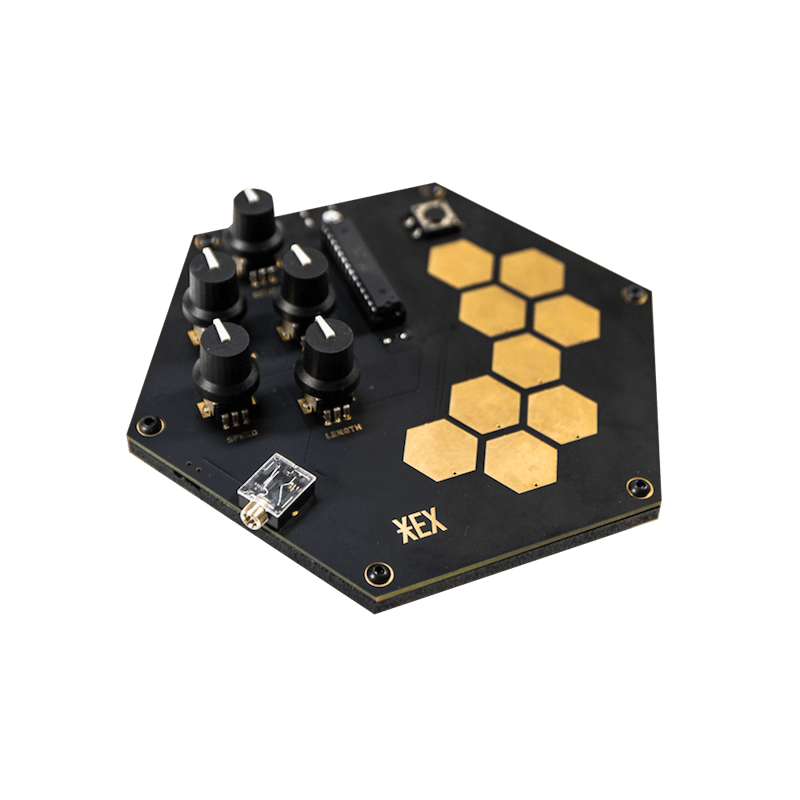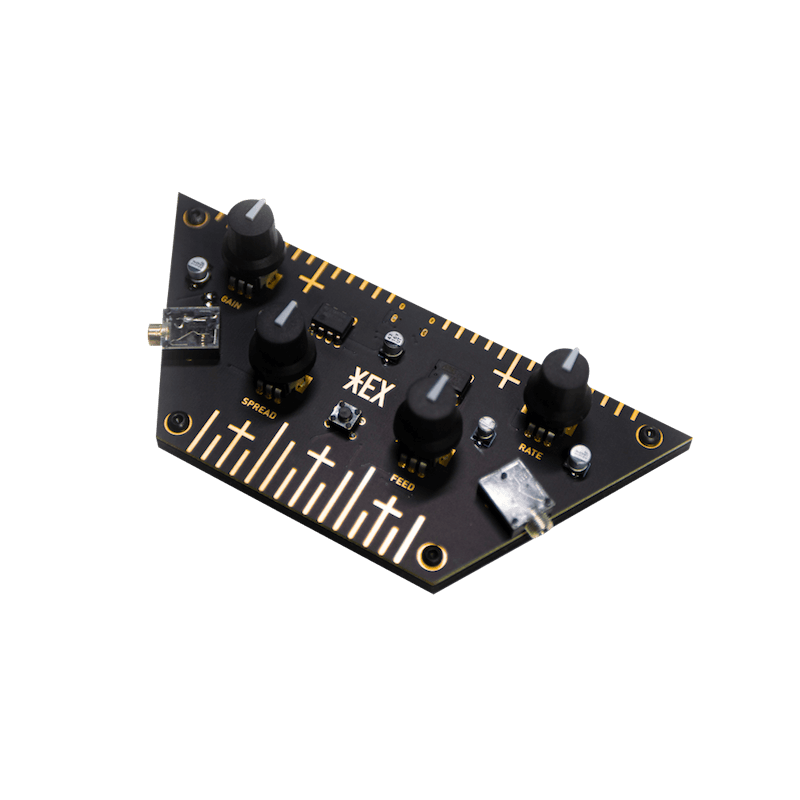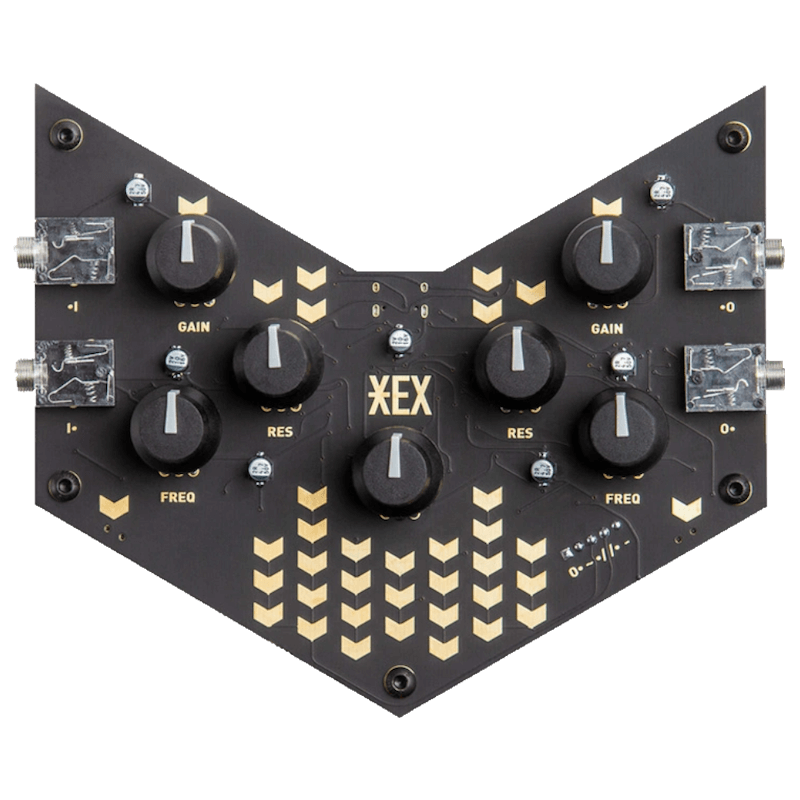Products of Hex Haus

A project by two post-alternative media artists. HEX HAUS – institute for development of new technologies is a joint project by media artists and fed up `post-alternative’ millenials Anže Sekelj and Staš Vrenko.
Hex Haus - HEX cor
available
HEX cor is a digital polyphonic synthesizer with a capacitive keyboard, potentiometers for signal modulation and an adaptable looper that through its unusual shape explores new ways of interaction and sound synthesis.Features:• Capacitive pads• Recording button• Octave• Waveform• Decay• Loop speed• Loop length• Sync switch• Header pins• 3,5 mm headphone jack output• USB C power portDIY-Kit-Type:SMD-Kit-2. This is a Do-It-Yourself kit, not an assembled module. The kit includes all parts to build the module. It includes SMD and through-hole parts! For build guide, more info, videos etc. please check the buttons below.
€97.37*
Hex Haus - HEX lag
available
Hex lag is a digital sound processing instrument with signal modulating potentiometers and an interactive tactile surface for direct sound control. It digitally simulates analogue bucket brigade delay chips (typical of chorus, flanger and karplus-strong), but also enables pitch-shifting, downsampling, etc.Features:• Touch pads• Gain• Rate• Spread• Feed• Push button• Header pins• 3,5 mm input• 3,5 mm output• USB C power portDIY-Kit-Type:SMD-Kit-2. This is a Do-It-Yourself kit, not an assembled module. The kit includes all parts to build the module. It includes SMD and through-hole parts! For build guide, more info, videos etc. please check the buttons below.
€97.37*
Hex Haus - HEX row
available
HEX row is an analogue dual resonant filter with versatile routing capabilities, sidechain/envelope follower and mischievous character, stemming from (mis)use of transistors as variable resistors in the signal route.There are two channels, each controlled by three potentiometers: GAIN (2), RES (3), FREQ (4) and sidechained by CENTER (5). Both channels have the same topology. Inputs •| and |• are fed into each channel’s gain stage and then passed to their filters. The input signal level can be adjusted by setting the GAIN which can either attenuate or amplify a signal x20. Note that the amplification affects the filter’s behaviour—high GAIN disrupts self-oscillation, conjuring PLL-esque harmonics and other sound design artefacts. FREQ and RES are used to manipulate individual filter’s cutoff frequency and resonance. Each channel has a side-mounted switch (6) for selecting low-pass or band-pass filtering. Touch the golden touch pads (1) to manually route the flow of audio and control voltages.SIDECHAIN – Left channel’s (•I, •O) post-gain signal is filtered and fed into an envelope follower. Envelopes polarity and amplitude are adjusted by using CENTER. The adjusted envelope is then mixed in the right(|•, O•) channel’s FREQ parameter. Left half of the CENTER causes the filter to “duck” and the right half produces a gating response. In the middle position, the sidechain effect is inactive.TOPOLOGIESFEEDBACK – Connect the •O and I• sockets with a jack cable and use O• as the main output. Leave •I unconnected as it’s normalised to O• by default.Alternatively, using stereo cables and a headphone splitter adapter enables the use of •O as output with dramatic stereo field dynamics.SERIAL – Connect the audio source to I• and use the •O as output.Input signals are processed through subsequent channels as •I is normalised to O•. This mode enables the so-called twin peak and auto-filtering.PARALLEL – Connect a stereo audio source into •I or two mono sources to •I and I•.Left and right signals are split into separate channels, processed and output as stereo signal via •O or as mono on both outputs.You will need a soldering iron, solder, pliers, tweezers and some patience. Before you begin the process, make sure you are working on a clean, well-lit surface. Be careful with the components, some of them are very small—take them out of the packaging one at a time, when needed. Most of the tiny SMD components are marked with numbers that match the numbers printed on the PCB. If you are new to soldering (SMD), we recommend watching some online tutorials beforehand. For the assembly video, visit our website. In any case, take it slow, go step by step and enjoy the process of building your HEX. It’s like a puzzle that you can use and play with afterwards. Oh, and if you have any questions, do not hesitate to contact us. Have fun!COMPONENTS1. 4,7uF capacitor / 5x2. 10uF capacitor / 2x3. Header pins / 1x4. 3.5mm jack / 4x5. Potentiometers + knobs / 7x6. Nuts + bolts / 5x7. PCB + wooden base / 1xDIY-Kit-Type:SMD-Kit-2. This is a Do-It-Yourself kit, not an assembled module. The kit includes all parts to build the module. It includes SMD and through-hole parts! For build guide, more info, videos etc. please check the buttons below.
€109.00*



